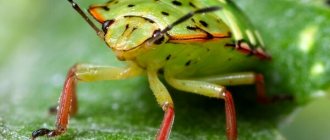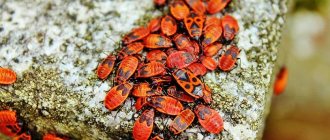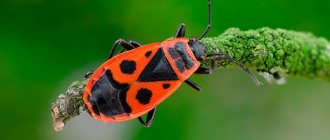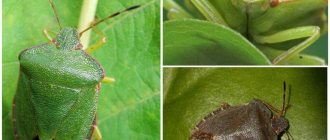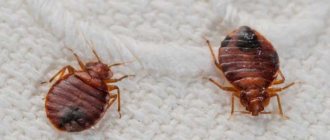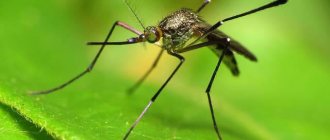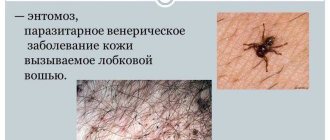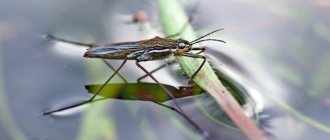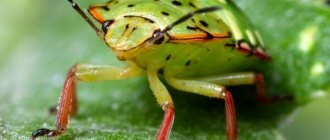Features of the species, habitat
The bug bug belongs to the family of stink bugs.
This species received this name for its appearance, since the body of the insect looks like a small turtle, and the relief and color of the elytra resembles a shell. The adult size varies from 10 to 15 mm in length. In everyday life, this species is classified as a grain bug. The popular name is due to the gastronomic preferences of the parasite. Photo of the turtle below.
Appearance
Turtle bugs belong to the order Hemiptera and have two pairs of wings. Pests fly well and easily move between food bases.
Interesting!
In search of food, shield turtles can cover enormous distances, migrating not only between fields, but also administrative regions.
Parasites show their activity with the onset of stable heat, when the temperature reaches 15 degrees above zero. The sex of the future insect does not play a role in the feeding intensity of the larvae. During this period, overwintered individuals begin to actively eat winter varieties of cereal crops. The tortoiseshell bug is especially common in wheat; it likes young, succulent stems.
After the larvae emerge from wintering to pupate, a period of intense mating and egg laying begins. Female turtle bugs lay 140 to 250 eggs in a short favorable period of just over a month.
Interesting!
The female bug bug has 14 oviducts in its abdomen, which allows it to lay 14 eggs at the same time.
Under favorable climatic conditions, the embryo develops within a week, after which the larva hatches. Its dimensions do not exceed 1.4-1.6 mm. From the moment of emergence until reaching the mature form, the larva has to go through 5 stages of development. With each phase, the appearance of the young individual becomes more and more reminiscent of an adult insect.
Appearance
During the growth period, the larvae actively feed and gain the mass necessary for transformation into the next stage. It doesn’t matter what the turtle bug eats, be it corn or wheat, but its mouthparts do not allow it to eat solid food. In the early stages of development, the larvae make punctures in the stems of plants and suck out its juices. Older individuals parasitize cereal seeds and inject a special enzyme to liquefy the hardened grains.
On a note!
The habitat of the grain bug is distributed from the steppe zone to forest-steppe. The insect is moderately thermophilic, therefore in the hot months, when the temperature rises to 30-35 degrees, it moves from fields to forest edges, to parks and squares.
During this period, pests are frequent guests in personal plots and cottages, where the bug damages corn crops or other succulent plants. By the time harvesting begins, insects have gained enough fat mass for a successful winter and, with the onset of cold weather, go into a dormant state.
General information
This species of bug belongs to the family of Scutellid bugs. When he sees a person or any other living creature, he immediately freezes and pretends to be dead. If this trick is detected, it activates special glands that emit a pungent and unpleasant odor.
Insect structure
The turtle has a short body (approximately 10-12 mm), which is colored in brown and yellowish shades, reminiscent of an army camouflage uniform. The pest's back is covered with chitinous armor, protecting it from numerous enemies. This bug got its name because of the shape of its body, which resembles a turtle shell. It has a flat body, thanks to which it fits tightly to the leaf or stem of the plant. In addition, the insect has strong and tenacious legs, which helps maintain position even in the strongest winds.
The insect's mouth is a pointed proboscis, with which it easily pierces the stems of agricultural crops and gets to the plant juice.
This video talks about the threat of a pest bug invasion:
Habitat and life cycle
The entire life cycle of the bug is inextricably linked with cereal crops; it lives near fields and agricultural lands. You can meet this insect in the following regions:
- North Caucasus;
- Volga region;
- Middle Asia;
- Ukraine;
- countries of the Balkan Peninsula;
- North Africa.
The invasion of harmful turtles can cause huge losses to grain crops
To winter, the bug moves to a nearby forest belt and hides under rotten leaves. It burrows to a depth of 3 cm and remains motionless throughout the cold period.
The harmful turtle wakes up in early spring, immediately after the snow melts. As a rule, in mid-March the earth warms up to a temperature of +15° - optimal conditions for the insect. During this period, bedbugs think only about food and actively consume young shoots. In case of cold weather, they are able to return to their shelter and wait for warmth.
As soon as the soil warms up to +20°C above, the pest begins to look for food more actively. In most cases, its target is winter crops. While searching for food, the insect can make fairly long flights (up to 200 kilometers). At the same time, they rise to a height of no more than 4 meters above the ground.
Bedbug nutrition
The basis of the diet is the stems of cereal crops. He eats them exclusively during the daytime and under suitable weather conditions. As the sun sets, turtles begin searching for shelter for the night. As a rule, they hide in small ground cracks in the field or simply bury themselves in the ground under a pile of leaves.
The nutrition process itself occurs in several stages:
- The turtle finds a young and succulent stem of a crop and securely attaches itself to it with the help of its powerful legs.
- After this, he pierces the stem with his proboscis, most often at the very base.
- Having completed all the preparatory operations, the bug begins to suck out the juice. At the same time, it secretes saliva, which contains a special enzyme that can break down carbohydrates.
The harmful bug sucks the juice from the plants and secretes enzymes, due to which their growth stops and the plants dry out.
The harmful bug damages the stem of the plant, due to which its growth stops and it dries out.
This pest is one of the most voracious. It is capable of destroying 10% of all plants per square meter of crops. This is a huge amount for such a small insect.
Bedbug larvae are also food lovers. They settle on the plant and damage its stem. As a result, flowers do not appear on the cereal and the leaves begin to dry out.
This insect causes the greatest harm during the period of grain ripening. At this time, the bug bug on wheat, millet or barley can ruin the entire spikelet and make it unfit for use by people.
Turtle Reproduction
This type of bedbug is one of those that can produce only one offspring in one season. Mating occurs immediately after hibernation or during a period when the air temperature exceeds +24°C.
After a few weeks, the female lays 10-15 eggs on the leaves of cereal crops or a weed growing nearby. She can repeat this procedure several dozen times, bringing the number of eggs laid to 200-300. Their number depends on the condition of the female and the presence of a constant source of food.
The eggs of the harmful turtle are located on the leaves in two identical rows. They resemble a small ball in shape and can be colored white, yellow or greenish. As they develop, the color of the eggs can change from green to bright brown. A few days before the larva is born, the color changes to pink.
A harmful turtle lays a large number of eggs during its life
The entire breeding process lasts no more than a month. The result is the birth of yellow-green larvae, which grow quickly and turn brown. During development, the larva goes through several stages:
- At the very beginning, it has a body length of approximately 1.5 mm. The shape resembles a slightly elongated ellipse.
- A week after hatching, the baby insects molt and become more active. Already at this stage of development, the larvae leave their place of birth and begin to feed on the juice of agricultural crops. During this time they grow up to 2.5 mm in length.
- The third stage lasts no more than a week. As a result, the larvae grow twice as big. At the same time, the insect slowly becomes similar to its parents. His head darkens, his abdomen lightens, and wings form.
- During this period of development, bedbugs increase to 6 mm in length, they develop a shield, as well as front wings.
- At the last stage, the young insect becomes exactly the same as its parents. At this time, the most active growth occurs, for which the bug absorbs a huge amount of sap from the plants.
The mature insect descends to the ground and freezes there until the protective cover hardens. The rate of development of larvae may vary depending on the weather and environmental temperature conditions.
Appearance of a turtle bug
A special feature of these bugs is their varied colors. The gray bug destroys the wheat crops, the green bug settles near the roots of the dill and on the raspberry bushes, and the brown bug eats the ovaries of the tomatoes. There are even insects that are green with light spots or red with black stripes.
This is due to the fact that insects adapt and change color to escape their natural enemies. Such mimicry is characteristic of the entire family of shield insects.
But representatives of this species have distinctive features that can be used to determine their belonging to the same family:
- flat round body from 8 to 14 mm in length and from 7 to 10 mm in width;
- two-layer wings in the form of a hard chitinous shield covered with dark spots and streaks;
- 3 pairs of limbs that allow you to quickly crawl and even swim in water;
- blunt head shape (with its base wider than its length);
- an insect's mouth, similar to a proboscis made of bristles;
- long thread-like antennae on the sides of the mouth.
The turtle bug has a variety of colors.
The chitinous shell resembles that of a turtle, hence the name of the flying pest.
How to get rid of bugs on plants
For different garden and vegetable plants, methods of control have their own characteristics. Also, control measures on a personal plot and on a farmer’s field will be different. Before poisoning stink bugs, it is necessary to check the weather forecast for the coming days. Substances that poison pests are easily washed off with water, so make sure that the weather center does not promise precipitation in the next 2 days.
To completely destroy bedbugs, treatment should be carried out twice with an interval of 15-20 days in order to get rid of not only adult insects, but also hatched young ones. The last treatment should be carried out no later than 2 weeks before harvest.
On wheat
The pest appears on winter wheat sprouts and barley seedlings when warm, dry weather lasts 3-4 days. If the fields are not cultivated before this time, they will be covered by a disease called “white ear”. This disease is determined by the light color of the ear, which will not be able to ripen and produce full-fledged grain. The reason is the stem damaged during the booting period.
The pest appears on wheat in dry weather.
The best time to monitor and treat crops is the second half of April, when warm daytime temperatures set in. If you are late with these actions, the plants will rise high above the ground and it will become difficult to detect the pest. Entomologists believe that a population of 3-4 shield insects per 1 m² already poses a danger to the crop.
Grain crops are treated en masse, by spraying over the fields, with chemical insecticides such as:
- “Contador Duo”;
- “Betadim”;
- “Kinmiks.”
The average consumption rate of the substance is 0.15 l/ha. These are two-component long-acting drugs that can be used against both larvae and adults.
On tomatoes
If mass wilting of tomatoes has begun in the area, this means that the bushes are infected with a pest. White or dark spots on the fruit are an indication that digestive enzymes have already entered under the thin skin of the tomato and the process of rotting has begun there. The berries become bitter in taste and cannot be stored for long periods of time.
If the tomatoes wilt, this means that the bushes are infected with a bug.
Intestinal poisons “Karbofos”, “Karate”, “Aktara” are well suited for spraying beds. If they enter the body of an insect, they disrupt digestion and lead to death.
On cabbage
The cabbage stink bug differs from the cereal one in color. The leaves of the cabbage are parasitized by brick-red bugs with black spots. They are also called “soldier bugs.” They are larger than their relatives and reach a length of 14 mm. They are easy to spot, but they need to be destroyed. The cabbage pest is characterized by increased fertility and accelerated maturation of the larvae. Two undetected “soldiers” in the spring can damage a large harvest.
Cabbage leaves become stained.
Cabbage leaves become covered with light yellow spots and subsequently begin to rot, infecting neighboring ones.
The cabbage stink bug can be repelled by the smell of black cohosh or kerosene. But if mass reproduction has already begun, then you will have to use the preparations “Belofos” or “Enzhio”, which have proven themselves excellent in the fight against bedbugs.
On the raspberry bushes
On raspberries you can find different types of stink bugs that parasitize berry bushes. These pests spoil currants, gooseberries, and honeysuckle. A distinctive feature of “raspberry” bugs is the greenish tint of their chitinous wings. They feed on the juice and pulp of the ripening crop, infecting it with a fungal infection.
The berries acquire a bitter taste and the smell of sour wine. Such raspberries are not even suitable for jam.
The best way to combat the parasite are bactericidal drugs: “Boverin” and “Bitoxibacillin”. These substances are safe for human health, but have a delayed effect and an unpleasant odor. Since the ripening time of raspberries is short, it is often impossible to get rid of this smell through natural ventilation. Therefore, summer residents choose a difficult and tedious way of fighting - collecting parasites with their hands in jars with a lid.
The use of chemical insecticides on berry bushes is strictly prohibited. This is due to the fact that it is impossible to wash off toxic substances from granular fruits.
Biological properties
This bug belongs to the class of insects, order Hemiptera (Hemiptera), family of shield bugs. The group of turtles is classified as a biological species of pests of cereal crops.
The insect reproduces bisexually and develops according to the type of incomplete metamorphosis, that is, bypassing the pupal stage.
With the onset of cold weather, young individuals hibernate, spending the winter under leaf litter in forest belts, gardens and summer cottages. The first bugs wake up in mid-April, when the daytime temperature reaches +14°C, and within a few days they fly to the fields. They move in the direction of the wind at a height of 2-3 m and cover distances of up to 100 km in search of food. At the moment of awakening, the number of males exceeds the number of females almost twice.
Males begin migration first, and by the time fertilization occurs, the gender ratio in the population is equalized. Depending on the geographical location, the flight takes time from mid-April to the end of May.
Habitats
The turtle bug is found in fields, summer cottages and vegetable gardens. It is rare in houses, even old ones. The insect is active in the dry and warm season, and with the onset of autumn it falls into torpor. It is believed that it was brought to Europe from warm tropical countries, where this species has a life cycle of up to 10 months a year.
The turtle bug is found in vegetable gardens and fields.
The pest survived, adapted to the continental climate and now causes enormous damage to grain and vegetable crops.
Its main habitats are steppes and forest-steppes; in cold regions, these flying pests do not have time to produce full-fledged offspring in a short summer.
Bug harmful turtle
The bug bug (Eurygaster integrariceps) is a dangerous cereal pest that is most active during the growth and ripening of wheat and other grain crops. This insect can be found on young wheat sprouts or on ears of wheat at the waxing stage.
Although the harmful turtle is primarily an enemy of large agricultural enterprises, the bug often causes damage to vegetable, berry and ornamental crops, so it is useful to know the nuances of pest control.
Life cycle
Active reproduction begins after wintering, when adult individuals gain strength and fly to fields and vegetable gardens.
1 female can lay up to 40 eggs in 1 clutch. During the summer season there can be 3-5 such clutches, depending on weather conditions. Insects make their first clutch 10-12 days after they find food.
The drier and longer the summer, the more active the pests are. Larvae emerge from eggs after 6-10 days and reach sexual maturity after 20-25 days. Externally, they differ from adult stink bugs only in size (2-5 mm in length).
The bugs that gave birth after winter die and are replaced by young pests that increase the population until the fall. Individuals at the adult stage go into hibernation; the survivors wake up and begin a new cycle of life.
The life cycle of an insect pest is interconnected with the development of cereal crops.
How to get rid of pests?
There are methods that can prevent the appearance of turtle bugs:
- the ripe crop must be harvested in a timely manner using a combine;
- wild weeds should be destroyed in a timely manner, but at the same time preserve the forest belt located along the perimeter of the site, and also not destroy the plants on which the enemies of turtle bugs live;
- fertilize fields with products containing phosphorus and potassium;
- for sowing, use varieties of grain crops that are resistant to these and other pests.
When insects appear, drastic steps should be taken to eliminate them. In this case, drugs containing targeted chemicals will be effective.
Important! Treatment should be carried out during the milky ripeness of the ear, when parasites are just beginning to colonize it. Only in this case will you achieve the best effect.
Aktara
An insecticide characterized by a wide spectrum of effects. The plants are treated with it using a backpack sprayer. It is necessary to spray the product in calm weather in the morning and evening. It should not be allowed to spread to neighboring crops.
Advice! Keep an eye on the weather forecast, as it is not recommended to use the drug if rain is expected in the coming hours.
Karate Zeon
Karate Zeon is an aqueous suspension that has a rapid effect on pests. At small dosages, this drug is capable of destroying a high percentage of the insect population. It differs from other products in its repellent effect, therefore it is absolutely harmless to bees.
The period of protective action depends on weather conditions and can reach 3 weeks. Bedbugs die 2-3 hours after treatment. The prepared solution cannot be stored; it must be used on the day of preparation.
Spraying can be done from the air or locally. Both the first and second insecticides will help you get rid of not only bugs, turtles, but also other pests.
At the first signs of the appearance of turtle bugs on your site, you must immediately take measures to destroy them. Any delay on your part can be disastrous for the entire harvest.
What does it eat?
The harmful bug is fixed at the base of the stem, because active growth processes take place there, the leaf structure is loose and juicy. Then it moves higher as the bud rises upward.
The insect makes a puncture in the plant with its sharp proboscis, introduces digestive enzymes that corrode the inside of the stem and cause it to rot. The bug sucks out the decomposed tissues of the plant, and it can no longer bear fruit, since the flow from the root to the ovary is disrupted.
Particular harm is caused to the following crops:
- wheat;
- millet;
- corn;
- oats;
- raspberries;
- tomatoes;
- sweet pepper.
The turtle bug damages wheat.
What does a pest bug look like?
Although the insect has a variety of colors: gray, brown-gray, yellow-gray, it differs from other pests in its very dense protective shell, which is covered with patterns - dots or lines - mostly these patterns are whitish, but sometimes they can have a light green or silver tint.
The pronotum of the bug is approximately twice the size of the head, the wings are rounded. This pest bug is an excellent flyer and can cover distances of up to 200 km in search of food!
With the help of a proboscis, the pest penetrates the stalks of wheat and sucks the juice from the capillaries of the plant.
Reproduction of harmful turtle
Life cycle: The adult bug bug undergoes a seasonal diapause that ends in the spring. In winter, it migrates to mountainous areas, and as the weather warms, the pest returns to cereal crop areas, where field populations gradually increase due to ongoing incursions.
Females lay eggs of 5-15 in clusters, mainly on the underside of the smooth leaves of plants. The sex ratio may vary depending on environmental conditions during embryonic development. High temperatures and humidity promote outbreaks of pest populations, while harsh winters negatively affect diapausing adults, reducing reproduction rates.
7-10 days after laying the eggs, larvae appear, which go through 5 stages of development and gradually approach the appearance of an adult.
If you are interested in learning more about this issue, we recommend that you study the photos, which visually show how the larvae differ at different stages of development.
The pest bug poses a great threat to the plants that are its source of nutrition. In winter, stink bugs take up temporary residence under fallen leaves in the forest or on evergreen weeds. Sometimes wheat barns can serve as a place for wintering.
With the onset of spring heat (10-15 degrees), bugs begin to fly and fly in search of early winter crops. As soon as they find a place suitable for feeding and a well-fed life, mass mating of males and females occurs.
Signs of a harmful turtle
Directly for people, this type of bedbug is harmless.
It does not bite, so even if the insect gets into the house, the easiest way is to throw it out the window. If you are unlucky and are still bitten by a bug, a mild allergic reaction may occur after the bite, but this is the maximum of bad things that can happen.
Before you can get rid of pests in your fields and gardens, you must first detect them. Further signs of grain spoilage by the pest bug;
- mass destruction of young shoots occurring in a specific area (if the bugs have not yet colonized the entire field);
- white-headedness or deformation of the original shape of the ear;
- In a ripe ear, you can notice noticeable chipping of the grain, a change in its color, and traces of a bug feast.
List of signs of parasitic activity:
- Inflorescence – panicle changes color, curls and loses shape
- Leaves – yellowed or dry
- Ear - discolored, with empty or shriveled grains, with a dead core
- Stems – discolor and die
- The whole plant is in the drying stage
The harmfulness of the turtle bug
This type of bug is a serious pest of cereal crops such as wheat and barley. In central and western Asia, it causes annual losses of 20-30% of barley and up to 100% of wheat. The entire crop may be destroyed if control measures are not in place.
If some of the damaged plants survive, this can lead to the appearance of “white ears”, a decrease in seed weight and germination rate.
In addition, wheat spoiled by the bug can negatively affect the quality of the flour itself.
After the bug is saturated with the juice of the grain crop, the beans will be completely unsuitable for further use. This is due to the fact that in the saliva of a harmful turtle there is a special enzyme that affects the chemical composition of the food product.
Unfortunately, it is almost impossible to distinguish affected flour from high quality flour when it is dry, since the enzymes lose their quality when dry. But as soon as the process of kneading the dough begins, the substance in the humid environment will begin to work again, and the consistency and color of the product will immediately change.
External signs of a harmful turtle
Country pests represented by the harmful turtle are unique representatives of the order Hemiptera. They are almost impossible to confuse with other insects, due to their characteristic color and body structure. An oval flat body with a fairly dense protective shield-shell is the main calling card of these bugs. The color can vary between several shades: gray, brownish-gray, yellowish-gray.
What remains surprising is the fact that bedbugs of this species, thanks to their powerful and well-developed wings, fly beautifully, and in search of food they can cover vast distances of up to 200 km. Other external features include a dotted and striped pattern on the shell, a small head (half the size of the body) and a piercing-sucking mouthparts, with which insects suck out juice from the capillaries of plants.
Moreover, their eggs also differ in their characteristics. They have a round shape, small size and greenish color. However, due to their color, they are not always noticeable on plant leaves, which often leads to a huge population of harmful turtles.
Benefits and harms
The harmful turtle is a malicious pest of agricultural crops that does not benefit farmers. In the summer, the bug is active, causing significant damage both in the fields and in granaries.
The bug harms cereals throughout the growing season. Its activities lead to:
- death of the central leaf on young stems;
- white-headedness (whitening followed by drying of the ear);
- deformation of the spine of the spikelets;
- damages wheat grains;
- the defectiveness of the grain and its emptiness.
The turtle causes harm in the following way: it pierces the young stem at the base with its proboscis, sucking the juices from the plant. The parasite injects saliva into the green organism, which contains a special enzyme that breaks down carbohydrates. The damaged plant stops growing and dries out.
Punctures of the stem by the bug before heading of cereal crops lead to underdevelopment of the grains. Wheat gluten loses its elasticity under the influence of the saliva of the harmful turtle. This has a bad effect on quality characteristics.
The bug is voracious. Five adult individuals can destroy 50% of the vegetation per 1 m² of planting. The larva of a harmful turtle causes no less harm. It damages the central leaf, and inflorescences on cereals do not form.
Reference. As the air temperature rises, the pest moves en masse into gardens and vegetable gardens. It is often seen on tomatoes, cucumbers, and raspberries.
By feeding on the sap of tomato seedlings, the parasite leads to a decrease in planting yield. The bug does not cause much damage to raspberries. The main danger from the pest's activity is posed to cucumbers.
Why are they dangerous?
The bread bug is a harmful turtle that is not dangerous for humans and pets. You can hold the turtle in your hand without fear of an insect bite. The pest is not able to bite through human skin.
Attention. This type of bedbug does not suck blood. The insect does not carry dangerous diseases.
The harmful turtle is not a predator and does not destroy other insects.
What to do if there is a wound in the house
A harmful turtle sometimes flies into the window by mistake. There is no suitable food for her in the apartment. Grains that are stored in homes in the form of cereals are unsuitable for this pest to eat.
If an insect was found in a residential area, there is no need to take measures to exterminate it. The bug should be released outside.
Appearance
The turtle bug looks like an amphibian with the same name and is strikingly different from other types of bugs.
- The round, convex brown shell provides reliable protection. Durable cover protects against negative factors and insecticides.
- Small antennae capture the smell of wheat from a great distance. Thanks to this, insects find fields with winter crops as soon as the plant emerges from the soil.
- 3 pairs of legs with tenacious claws allow the pest to move freely around the plant in a vertical or horizontal position.
- Easily recognizable body color. There are patterns, stripes, and spots on the shell. The color itself can be light brown, yellowish, gray.
- The mouthparts are piercing-sucking. The pest easily pierces the leaf plate and stem. It sucks out juices through its proboscis.
- The eggs of the turtle bug are round, green, and located close to each other. Using a magnifying glass, you can examine the larva that develops inside. They are born as small bugs that are distinguished by their dark color and size.
A photo of the harmful bug is located below. The insect is easily recognizable, just like the soldier bug lives in colonies, so it’s easy to notice the pest. You need to look under the back of the leaf, or carefully examine the spikelet.
Signs of insects
to establish that a turtle bug has appeared on the field. The main signs of the presence of a pest include:
- The occurrence of a harmful bug can be determined by the area of land where plants have begun to wilt en masse.
- If you examine the seedlings, you will notice a whitish tint and deformation. This means that the tortoise beetle has damaged the ears of wheat or other cereal crops.
- After the feast of the harmful turtle, changes in the grain are noticeable. There are bite marks and puncture marks on it.
Bugs: eggs, nymphs and adults. Identification and destruction The harmful turtle has learned to choose the most nutritious plants. Such crops are the most succulent and grow quickly.
The turtle is absolutely harmless to humans. If a bug bites, the maximum will cause a minor allergic reaction. Therefore, if an insect accidentally gets into your house, you should not take radical measures, just throw it outside.
After a bug attacks a plant, it is deprived of all its juices and all that remains is to throw away the grain. This is explained by a special enzyme that is found in the pest’s saliva. It can influence the chemical composition of the product. Such a substance enters the stem through the insect’s proboscis when pierced, after which it spreads to the entire ear of wheat.
The resulting flour is already contaminated and does not differ from high-quality flour, since the enzymes stop working in dry conditions. But as soon as you knead the dough, the substance “wakes up”, begins to act and becomes noticeable. Under its influence, the color of the product and consistency become different - the kneaded dough acquires a dark gray color and a viscous structure. The housewife can only throw away both the dough and all the contaminated flour.
What harm can it cause
Being a completely safe insect for humans, the turtle bug causes great harm to cereal crops. By parasitizing grain crops, tortoiseshell bugs significantly reduce their yield. At the same time, damage is caused to both small private gardening and agricultural lands.
It is known that the insect feeds on the sap of plants, mainly cereal crops. To obtain it, the pest pierces the stem or spikelet and, thanks to special saliva, first ferments the contents, after which it eats it.
Ears of corn that have been visited by the turtle bug develop more slowly or stop growing altogether.
Wheat damaged by pests becomes unsuitable for further use. Flour made from contaminated grains is not suitable for baking, because under the influence of temperature and moisture it becomes stringy and changes color.
Experts speak of economic damage to a farm when 2–5 larvae are detected per square meter of crop area.
Wheat is likely to have come into contact with the tortoiseshell bug if:
- young shoots suddenly begin to wither;
- the color of the ears and shoots changes and becomes white;
- adult grains have small, barely noticeable chips and dots on their surface.
The turtle bug is a very mobile insect, so when it first appears, measures must be taken to prevent further spread of the pest.
Effective drugs
Insect control
How to treat wheat fields is an individual choice. There are many combination products available on the market.
- Aktara. A highly effective drug with an immediate effect. Treatment is carried out by spraying. Within an hour, the harmful turtle stops feeding and dies within 24 hours. The active components of Aktara provoke muscle paralysis and inevitable death of the harmful insect. It remains valid for about 30 days. Effectiveness is not affected by weather conditions unless it rains within 2 hours of spraying.
- Karate Zeon. A professional product to combat harmful insects. Available in the form of a concentrated emulsion. Before use, it must be diluted in cool water. It acts similarly to the first drug. Damage can be healed within a few days.
You can achieve quick, long-term results using combined methods. The use of poison in early spring significantly increases the chances of victory; by the time of harvest, the toxins are destroyed. The grain does not lose its taste and beneficial qualities. The owners of the fields reap a rich harvest.
It is necessary to periodically inspect fields with grain crops. Take emergency measures immediately after detecting a pest.
Methods to combat the harmful bug bug
Knowing what measures can be used to control the pest bug is extremely important and even necessary. This will reduce the number of pests and maintain high grain quality.
At the moment there are special preparations, insecticides that can be sprayed on the fields. It is recommended to alternate medications intended to combat harmful turtles to avoid adaptation of adult bedbugs and larvae to the poison.
Basic methods
Pest control has always been a priority for agricultural land owners. Over the years, tactics have been developed that reduce the number of pest bugs without harming crops. Among them are the following:
- Ripe grain crops must be harvested on time and only with the help of a combine.
- It is necessary to constantly maintain the cleanliness of the crops. To do this, it is necessary to promptly remove all weeds and preserve the forest area around the perimeter.
- Help plants that serve as a home for insects - enemies of turtles - to grow and develop.
- Fertilize the soil with products that contain phosphorus and potassium.
- Grow varieties of grain crops that can withstand pest attacks.
It is necessary to carefully care for and monitor crops to prevent insect infestations.
Chemical methods
The optimal time to apply chemicals (such as organophosphates or pyrethroids) is when 40% of the population consists of second instar larvae.
This prevents the subsequent emergence of adults. Depending on the pest population, spraying may not be necessary.
Biological method
Biological control of harmful turtles is possible. There are several species of spiders that prey on this pest.
The method works when only small populations of first-generation adults are found and when at least 40% first-instar, 50% second-instar, or 70% third-instar larvae are present, no chemical control is required. Entomopathogenic nematodes and various isolates of entomopathogenic fungi destroy pests.
Preventive measures
To preserve the harvest and avoid an increase in the number of insects next season, the fight against bugs must begin with preventive measures.
For this it is recommended:
- Fertilize the soil with mineral complexes containing potassium and phosphorus.
- Harvest as quickly as possible. If it remains in the field for a long time, it may become affected by parasites.
- Destruction of weed plants whose leaves may contain bugs.
- Additional processing of grain, cleaning it from debris and dirt, drying it
Experienced farmers recommend planting grains in areas surrounded by plantations or forest. Trees will become an insurmountable obstacle for this type of insect and will force them to look for another place for their settlement; in addition, “enemies” of turtles live on forest plantations: spiders, birds, ants.
Natural enemies
One way to regulate the turtle bug population is to attract its natural enemies. People have learned to use several types of insects for these purposes . The most popular among them:
- Telenomus. This type of parasite looks like a small fly. Its usefulness lies in the fact that it lays eggs only in places where there is already a clutch of another insect. The result of this activity is the destruction of all eggs of the harmful bug.
- Phasian fly. This insect lays eggs directly on the turtle's body. When the larvae reach the desired stage of development, they will emerge into the light and begin to eat the nearest prey (harmful bug). A popular bedbug control practice is to breed insects in fields that counteract harmful bugs.
- Predatory ground beetles. These representatives of the fauna feed on all types of insects, including turtles.
- Spiders. Some species of these creatures will also not refuse a bedbug dinner.
- Forest ants. They are capable of eating almost all living creatures that come their way. The presence of such ants in the field will protect the crop not only from bedbugs, but also from other pests.
Today, there are several research institutes that study pests and look for methods to combat them. To do this, the necessary insects are grown in laboratories and released onto the field at the right time.
traditional methods
The fight against the turtle bug is possible not only with the help of insecticides. There are several simple recipes that will help you quickly get rid of unpleasant insects.
- Onion peels are poured with boiling water. The mixture is infused for a week, after which the tomatoes are treated with it.
- Dry mustard powder is diluted with water in a ratio of 1 to 4. After this, the resulting mixture is poured into cool water and used to treat young shoots.
- Garlic powder in the amount of four teaspoons is placed in a liter of water. The solution is used to treat tomato leaves.
However, it is necessary to understand that using folk methods you will only repel bedbugs, but will not achieve their destruction. But this will help protect the plants from pests for a while.
rules for processing tomatoes
Fighting turtle bugs using chemicals is quite effective, but it is worth remembering the toxicity of these drugs. Before directly processing tomatoes, you must pay attention to the instructions and act according to them.
Remember that the pest is able to develop immunity to the drugs used against it. The longer you fight bugs, the more lethal dose you will need, which will have a bad effect on the plants. To avoid this, use different medications.
Additional measures
In addition to carrying out all the mandatory measures to protect crops from harmful turtles, additional methods can be used. Despite their simplicity, they are effective and significantly reduce the risk of pest occurrence. These include:
- Burning fallen leaves in neighboring plantings before the onset of cold weather. This will destroy the insects hiding in them, preparing for hibernation. Burning of fallen plant leaves is carried out to destroy the eggs of harmful turtles.
- Sowing false fields with useless or low-quality cereal crops. There is a high probability that pests will settle there and will not cause harm to the main crop.
- Fallen leaves are buried in deep holes along with wintering insects.
Natural enemies
Natural enemies of the harmful turtle include:
- predatory beetles;
- spiders;
- ants;
- birds.
Other enemies of the bug:
- The greatest danger to the bug is the tachina fly, called the golden phasia, and the Telenomus egg eater.
- Telenomus makes a clutch in the turtle egg, from which the larvae subsequently emerge. They eat the contents of the egg, leaving an empty shell.
- Contact with the gray phasia fly is also detrimental to the bug. She lays eggs on the body of a harmful turtle. The emerging larvae make their way inside the pest, weakening it and depriving it of the ability to reproduce.
- In the wintering area, bedbugs suffer from ground beetles and rove beetles. The species is also threatened by attacks from forest ants.
The harmful turtle is the most dangerous pest of cereal crops, causing significant damage to the agricultural industry. Using preventative measures helps prevent the problem. If infection occurs, it is necessary to immediately treat the crops with preparations with insecticidal properties.
Danger to humans and animals, harm to agriculture
Despite the fact that the oral apparatus of all bedbugs has the same structure, not every species parasitizes animals while feeding. The pest bug cannot cause physical harm to a person or other warm-blooded animal, despite its menacing appearance.
Appearance
On a note!
Sometimes pests accidentally fly into a living space, but do not pose any threat. But it is not recommended to pick up stink bug with bare hands, as it secretes a special, strong-smelling enzyme to repel birds of prey. Therefore, the insect is often called the stink bug.
Shield turtles harm agricultural plants. Their favorite food is crops of barley, corn or other valuable cereal crops. The bug most often parasitizes wheat. Sometimes during the period of mass reproduction, pests reduce yields by 15%, causing severe economic damage not only to agricultural organizations, but also to private gardening and household plots.
The pest bug feeds on plant sap; to do this, it pierces the stem or ear and ferments the internal contents, and then sucks it out. Corroded crops are severely stunted in growth and do not reach the required ripeness.
On a note!
Grain damaged by the bug loses its marketable value and is practically unsuitable for making flour. The product obtained from grains contaminated with enzymes is not suitable for baking; it has a gray color and is very sticky when kneading the dough. To obtain high-quality wheat bread, the flour should not contain damaged grains.
The main signs of damage to crops by the pest bug are:
- wilting of young shoots at the source of infection;
- white color of ears and shoots;
- the presence of microscopic chips and spots on mature grains in places where bugs have bitten.
On a note!
The pest bug prefers the most valuable and expensive types of crops as food.
Due to its high mobility, the insect very quickly colonizes large spaces, increasing its numbers and, without special protective measures, is capable of destroying crops over vast areas.
The harmfulness of the turtle bug
The bug flies well and can cover long distances. This insect is completely harmless to humans; it cannot bite through the skin and cause allergies. If such a bug accidentally ends up in an apartment, you can simply throw it away.
Thanks to the structure of the mouthparts, the pest bug makes injections into the stem of the plant, feeding on its juices. Depending on the phase of plant development in which the damage was done, growth slows down, flowering and ear filling are delayed. By injecting into the grain, the bug introduces its enzymes there along with saliva, which deteriorates the baking properties of the flour. The turtle bug harms not only industrial crops, but also plantings of ornamental cereals on a personal plot.
Important! The turtle bug can be detected by lesions where young shoots wither, a change in the shape of the ear, or grain deformation is observed. These insects prefer the strongest plants that can produce juices in large quantities.
In the photo - a harmful bug in two morphs (brown and black) on a damaged ear
Prevention
To prevent pests from appearing, it is necessary to regularly carry out preventive measures:
- The use of planting material of varieties that are quite resistant to infection by harmful insects;
- Fertilizing the soil with preparations containing potassium and phosphorus;
- Constant weed control;
- Planting shelterbelts or areas of abundant vegetation near fields. The enemies of harmful turtles will settle in them: beetles, ants, spiders and birds;
- On a small domestic scale, bedbugs are fought with the help of chickens. Each chicken destroys 1,500 parasites per day;
- Timely collection of ripe harvest. A combine is used for this.
What to do with turtle bugs:
For humans, bugs are not dangerous, but for agriculture they are a big and serious threat. Knowing its appearance, the characteristics of its behavior, what ways to fight them, as well as taking the necessary preventive measures, all this will allow them to be completely destroyed. Integrated control will help preserve the harvest.
Consequences of the appearance of a harmful bug
A large concentration of bugs of the pest bug species can ruin not only the harvest, but also the final product. Flour from grains damaged by bedbugs in dry form is almost impossible to distinguish from high-quality flour; it looks the same. The difference will only become noticeable when the product is placed in a humid environment. It will change both consistency and color. Flour from damaged grains will produce a viscous and stringy dough, which also has an unpleasant dark gray color. The saliva of the turtle bug contains a certain enzyme that can change the chemical composition of grains. It is activated when insect-damaged products are placed in liquid, the result of which can be observed without special laboratories, with the naked eye. To avoid this, you should start fighting bugs for healthy and natural grains.
